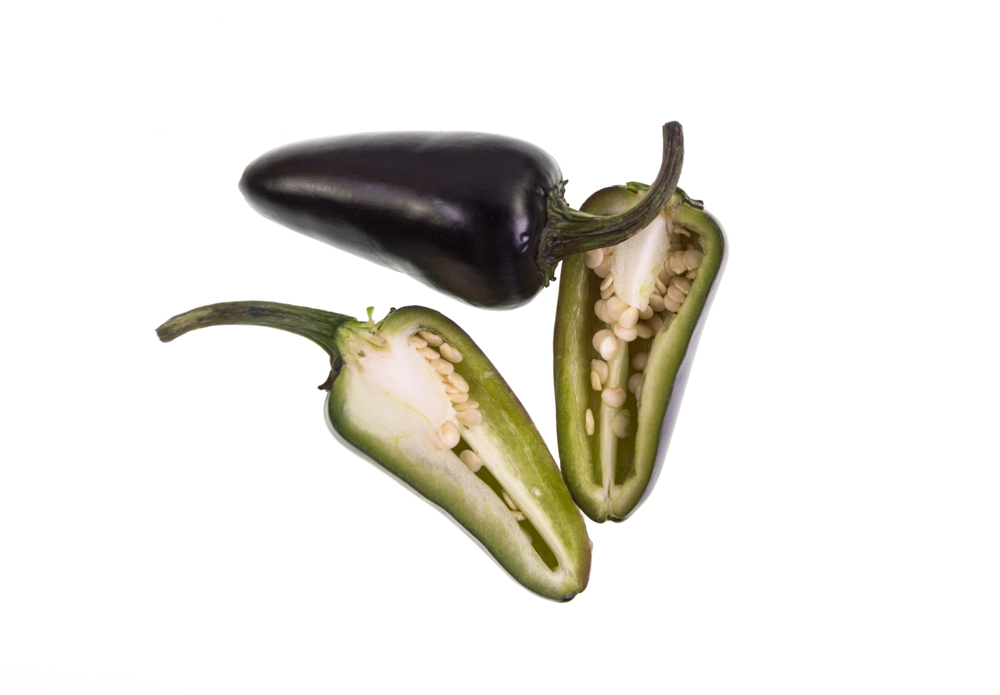You know that jalapenos are green and sometimes red, but many don't realize they can also be purple! Purple jalapeno is a prolific ornamental pepper plant that produces medium-heat purple fruit and can also have green and red growing simultaneously.
What Are Purple Jalapenos?
This unusual jalapeno is an heirloom cultivar of Capsicum annuum. The fruit goes from green to a deep, almost blackish-purple color, to red upon full maturity.
Because these plants are high producers, there are times when all three colors are present at the same time, creating a colorful spectacle. The purple flowers that give rise to the fruit make the purple jalapeno a beautiful addition to any garden.
You can eat the peppers at any stage, but as with all hot peppers, the longer they remain on the plant, the spicier they will become.
How Hot Are Purple Jalapenos?
Purple jalapenos are medium-heat peppers with approximately the same heat range as their green and red cousins. On the Scoville heat scale, they measure 2,500-8,000 Scoville heat units (SHU), though they tend to sit at the top of the range because they’re left to ripen longer.
For reference and to understand where the capsaicin level in the purple jalapeno ranks amongst other popular hot peppers, consider the following chart:
- Carolina reaper, 2,000,000 SHU
- Habanero, 150,00-575,000 SHU
- Serrano, 10,000-25,000 SHU
- Purple jalapeno, 2,500-8,000 SHU
- Bell pepper, 0 SHU
Purple Jalapeno Vs. Green Jalapeno Vs. Red Jalapeno
The three primary jalapeno varieties are very similar to one another. They aren’t identical, however. The chart below illustrates some of the primary differences.
| Green Jalapeno | Red Jalapeno | Purple Jalapeno | |
| Appearance | Eaten green, unripe | Ripe version of green | Turns green to dark purple when ripe |
| Size | 2-3″ | 2-3″ | 3-5″ |
| Heat | 2,500-8,000 SHUs | 2,500-8,000 SHUs | 2,500-8,000 SHUs |
| Maturity | 70-85 days | 85+ days | 85+ days |
| Flavor | Fresh, grassy, verdant | Sweet, vegetal | Sweet, earthy |
You should note that red jalapenos are green jalapenos that have been allowed to ripen longer. The more time a pepper spends on the plant, the more capsaicin it develops. This is why, even though green and red jalapenos have the same SHU range, the red ones will be closer to 8,000 SHUs while the green ones will be closer to 2,500 SHUs.
You can find green jalapenos in nearly any grocery store. The red version is more challenging to locate and is often confused with common Fresno chilis.
How To Use Purple Jalapenos In Cooking
Purple jalapenos can be used in the same manner as regular jalapenos. They’re slightly sweeter and hotter than the green variety, but the dark purple color makes them stand out in any dish.
They’re an excellent addition to salsas and make an exciting and beautiful garnish to soups like pho or salads. Other uses for purple jalapenos include:
- Pickling
- Purple jalapeno hot sauce
- Salsa (substitute the green jalapenos for purple ones in this beautiful cranberry-jalapeno salsa for the holidays!)
- Marinades
- Jalapeno cream cheese dip (the purple color is stunning!)
Where To Buy Purple Jalapenos
Purple jalapenos are seldom found fresh in mainstream grocery stores. Some specialty markets may carry them during the growing season, but call ahead to check before making an unnecessary trip.
Can You Grow Purple Jalapenos?
If you want purple jalapenos, your best bet will be to grow them yourself. They’re easy to grow, and you can find purple jalapeno pepper seeds at online retailers like Amazon or in specialty seed catalogs.

Purple jalapenos are a cultivar independent of regular jalapenos and different from what’s typically found in stores and nurseries. You want to be sure that what you purchase specifies “purple jalapeno.” Because peppers change color as they mature, there needs to be more clarity in the marketplace.
Like all peppers, purple jalapenos prefer full sun and warm weather. They thrive in USDA climate zones eight and above. Still, they can survive and produce an abundance of peppers anywhere the daytime temperature is above 80 degrees for an extended time.
- Start seeds inside 6-8 weeks before the last frost.
- Expect germination between 7-15 days after sowing.
- Transplant outdoors when the seedlings have at least three sets of leaves and the soil temperature is 70 degrees or warmer.
- Peppers like to dry out a bit in between watering and never like to sit in wet soil. To check soil moisture, stick your finger half an inch into the ground. If it feels moist, wait a day or two. If it’s dry, then it’s time to water.
Jalapenos of all colors make good companion plants for other vegetables as well. Tomato, tomatillos, and cucumbers are all excellent choices for companion planting. If you have space and the inclination, purple jalapenos can fit nicely into a salsa garden.
Tip: Planting marigolds in and around the garden is a natural way to prevent many typical garden pests from bothering your plants.
Substitutes For Purple Jalapenos
If growing your purple jalapenos isn’t an option, many suitable alternatives exist for this colorful chili pepper.
The most obvious substitute for flavor is green or red jalapeno. Both will maintain your dish’s flavor profile and relative heat scale.
Other options include:
- Pretty in purple – Vibrant purple color and jalapeno-like heat, but the peppers are tiny so they will only work in dishes where they’re finely diced. This pepper is primarily grown for decorative purposes, so don’t expect a very robust flavor profile.
- Purple beauty peppers – These are purple sweet bell peppers with 0 SHUs. They’ll give you the purple color without any heat.

